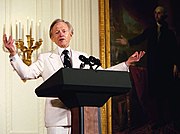Tom Wolfe's Human Design Chart
6/2 Emotional Projector**Tom Wolfe: A Human Design Perspective**
Tom Wolfe was an acclaimed American writer and a pivotal figure in the “new journalism” movement of the 1960s, known for his unique blend of factual reporting and literary flair. Born on March 2, 1930, in Richmond, Virginia, Wolfe was the first-born child of a college professor and a homemaker. His early fascination with historical figures like King Arthur and Napoleon significantly influenced his narrative style, while his high school years saw him co-editing the student newspaper and pitching for the baseball team.
Wolfe’s Human Design as a Projector with Emotional Inner Authority shaped his approach to both life and literature. As a Projector, he was designed to guide others and share his insights, but he thrived on the energy of invitations, often waiting for the right opportunities to express his creativity. This strategy allowed him to observe the world deeply before stepping into the spotlight, a trait reflected in his 6/2 Profile. The 6/2 Profile embodies a blend of wisdom and a natural tendency to retreat and reflect, which is evident in Wolfe’s soft-spoken demeanor contrasted with his ability to provoke thought and stir controversy through his writing.
His groundbreaking work, particularly the novel “The Right Stuff” (1979), showcased his talent for capturing the zeitgeist of an era, although the film adaptation did not resonate with audiences. Wolfe’s 1987 best-selling novel, “Bonfire of the Vanities,” received both acclaim and criticism, while its Hollywood adaptation fell short of expectations. His distinctive sartorial choices, including custom-made suits in vibrant pastels, were a reflection of his desire to be seen and elicit reactions, aligning with his Projector nature.
Wolfe’s career began as a cub reporter for the Springfield Union, quickly advancing to roles at the Washington Post and the New York Herald Tribune. In 1963, a long strike of New York newspapers led him to write for Esquire, where he pioneered the non-fiction short story format, blending factual reporting with emotional depth. His first book, “The Electric Kool-Aid Acid Test” (1968), became an instant bestseller, solidifying his reputation as a leading voice of his generation.
Despite his flamboyant public persona, Wolfe maintained a private life, often shying away from discussing personal matters, including his children, Alexandra and Thomas. His marriage to Sheila Berger, former art director of Harper’s magazine, was a significant aspect of his life, as was their residence in a New York townhouse.
Wolfe’s journey was not without challenges; he experienced a heart attack in 1996, followed by a quadruple bypass surgery, which he largely kept out of the public eye. His Emotional Inner Authority likely influenced his creative process and personal struggles, including a deep depression following his surgery. His final novel was published in the autumn of 2004, and he continued to leave an indelible mark on American literature until his passing on May 14, 2018, in Manhattan, New York, at the age of 88.
As a Projector with channels 26-44, 37-40, and 28-38, and with the Incarnation Cross of Left Angle Cross of Migration (37/40 | 5/35), Tom Wolfe’s legacy as a master of narrative will continue to inspire writers and readers alike. His Human Design reflects the complexity of his insights and the profound impact of his work on journalism and literature, highlighting the unique interplay between his personal experiences and his creative expression.
Discover More Famous People
Browse and analyze over 55,000 public figures and celebrities.
Ra Uru Hu
5/1 Manifestor
Martha Stewart
4/6 Manifestor
David Lynch
4/6 Generator
Barack Obama
6/2 Projector
Steve Jobs
6/3 Generator
Vladimir Putin
5/1 Manifestor
Kim Kardashian
3/5 Generator
Michael Jackson
1/3 Projector
Marilyn Monroe
6/2 Projector
Ariana Grande
2/4 Projector
Oprah Winfrey
2/4 Generator
Johnny Depp
2/4 ManifestorWhat is HumanDesign.ai and how does it work?
Curious what makes Tom Wolfe tick? HumanDesign.ai instantly maps their exact birth data into a fully interactive clickable bodygraph chart, letting you hover or tap every center, channel, and gate for plain-language explanations. Bella, the platform’s built-in AI guide, adds context in real time, translating complex mechanics into everyday insights so you can see how Tom Wolfe’s strengths, challenges, and life themes play out on-screen.
The same tools are waiting for you. Generate your own Human Design Chart in seconds, open a library of 2000+ suggested questions, and chat with Bella as often as you like to decode your design, daily transits, and even relationship dynamics.
Want to compare energies? Save unlimited charts for friends, family, or clients, then ask Bella to reveal compatibilities, composite patterns, or coaching tips, all in one conversation thread.
Start free with core features, or unlock our Personal and Pro plans for deeper dives: unlimited Q&A, celebrity chart search spanning 55,000+ public figures, white-label PDF reports, branded content generation, and a professional profile with built-in booking for practitioners. Whether you’re exploring your own potential or guiding others, HumanDesign.ai delivers an ever-expanding toolbox of AI-powered insights—no spreadsheets, no jargon, just clarity at your fingertips.
Ready to see yours? Signup for FREE today!

